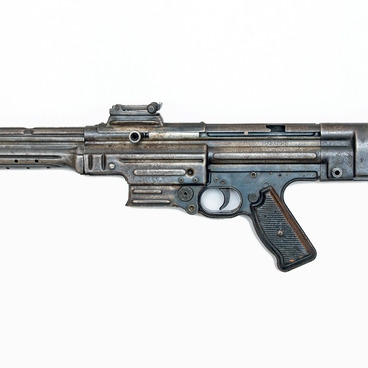The exhibition of the Victory Museum includes a famous German machine gun. The MG 42 is justly considered a unique weapon. Unlike many other models which have undergone certain changes and modifications, this machine gun is still used by armies in its original version.
At the beginning of World War II, the German forces used another machine gun model known as the MG 34. However, it was more expensive to produce at an industrial scale and had the disadvantage of being sensitive to dirt. It was also difficult to disassemble and maintain. All of this resulted in the decision to modernize the machine gun, and companies were commissioned to design a simpler and more efficient weapon.
The design of the machine gun was developed by two engineers — Werner Gruner and Kurt Horn. In late 1941, the first MG 42 machine guns were sent to the Eastern front for field trials, and in 1942, this model was adopted into service by all branches of the German military forces. However, the production of the previous version did not stop. The MG 42 was manufactured by the factory of Johannes Großfuß in Döbeln.
The machine gun had numerous advantages. It was made largely out of pressed and stamped details which reduced the complexity and costs of manufacturing significantly. Most riveted and screwed conditions were replaced with spot welding. Workers did not need a lot of skill to produce such weapons. The buttstock was made of plastic instead of wood.
In case of prolonged firing, the barrel could be easily changed in a matter of seconds. Due to the specifics of the trigger mechanism, only continuous fire was possible. The machine gun had a simple structure that was easy to disassemble and reassemble.
The machine gun was adopted by the armies of various European countries, as well as Israel, Pakistan, Turkey, and the United States. It was produced in Germany and Spain. The famous firearm has been used in numerous war-related artworks including books, movies, and visual art.
At the beginning of World War II, the German forces used another machine gun model known as the MG 34. However, it was more expensive to produce at an industrial scale and had the disadvantage of being sensitive to dirt. It was also difficult to disassemble and maintain. All of this resulted in the decision to modernize the machine gun, and companies were commissioned to design a simpler and more efficient weapon.
The design of the machine gun was developed by two engineers — Werner Gruner and Kurt Horn. In late 1941, the first MG 42 machine guns were sent to the Eastern front for field trials, and in 1942, this model was adopted into service by all branches of the German military forces. However, the production of the previous version did not stop. The MG 42 was manufactured by the factory of Johannes Großfuß in Döbeln.
The machine gun had numerous advantages. It was made largely out of pressed and stamped details which reduced the complexity and costs of manufacturing significantly. Most riveted and screwed conditions were replaced with spot welding. Workers did not need a lot of skill to produce such weapons. The buttstock was made of plastic instead of wood.
In case of prolonged firing, the barrel could be easily changed in a matter of seconds. Due to the specifics of the trigger mechanism, only continuous fire was possible. The machine gun had a simple structure that was easy to disassemble and reassemble.
The machine gun was adopted by the armies of various European countries, as well as Israel, Pakistan, Turkey, and the United States. It was produced in Germany and Spain. The famous firearm has been used in numerous war-related artworks including books, movies, and visual art.


